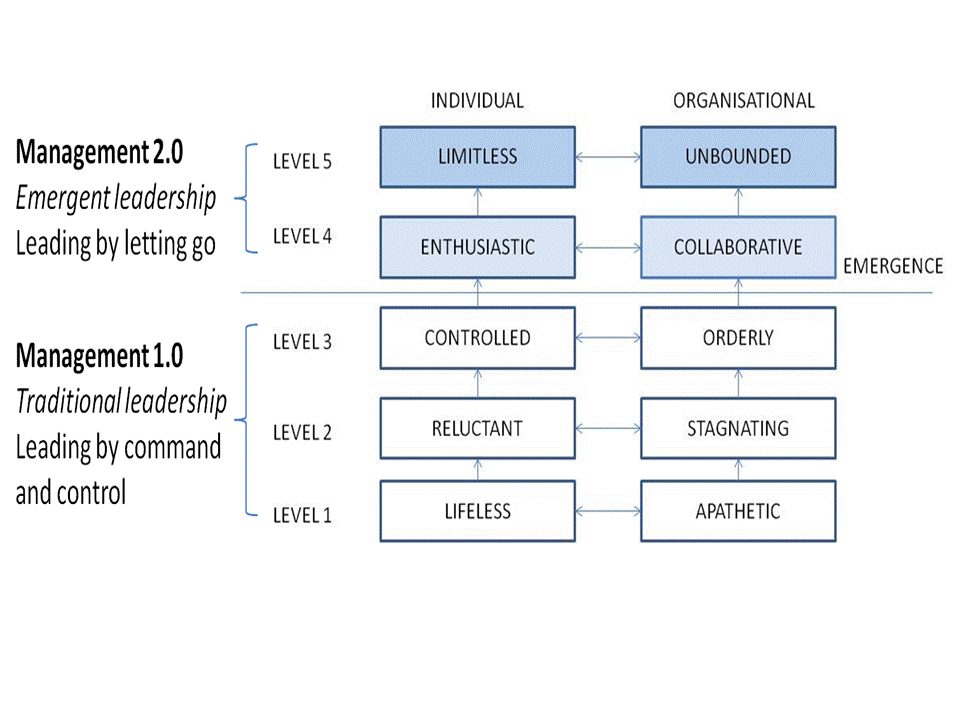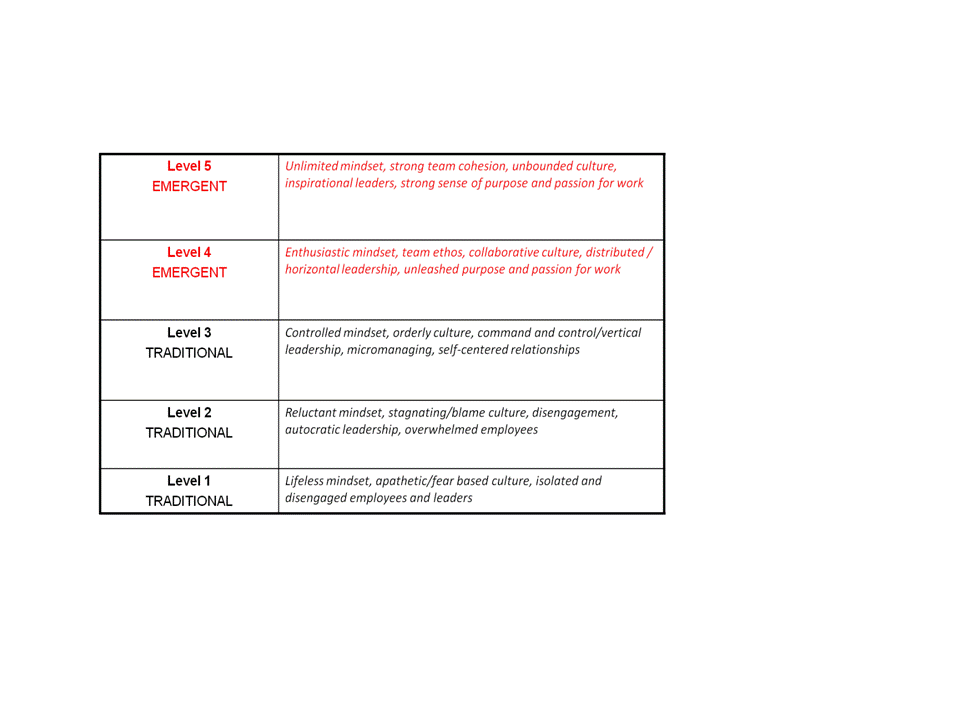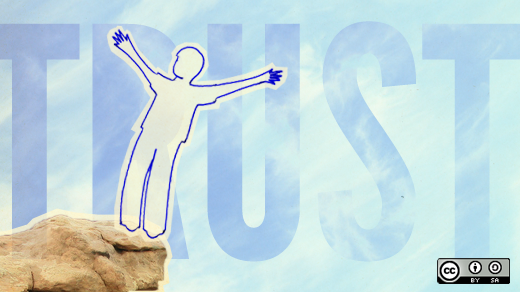Organizations today face unprecedented challenges. A recent IBM sponsored global survey found that the key challenges CEOs face today are rapidly accelerating pace of change and complexity. Furthermore, performance continues to decline whether measured through Return on Assets or Return on Invested Capital; U.S. firm's Return on Assets has progressively dropped 75% since 1965, as Peter Drucker pointed out in 1999, management has done much to automate work with mechanizations improvements during the 20th Century of 50/1. What remains however, is improving the effectiveness of the knowledge worker. Furthermore, data shows that only 25% of the workforce is passionate about their work, despite the plethora of techniques and resources spent on L&D and global figures for engagement show that 80% of employees are less than fully engaged at work.
This article was originally posted on the Management Innovation eXchange (MIX), an open innovation project aimed at reinventing management for the 21st century.
The key cause of this problem is outdated management practices from the last century based on mechanistic paradigm, hierarchical command and control mindset, bureaucratic processes and standardization. This approach worked well for driving productivity and efficiency in production economy but is detrimental for innovation and engagement which are the key ingredients for success of modern organizations moving towards creativity economy. Current mechanistic management practices fuel mismatch with knowledge workers needs. Research shows that they ignore corporate hierarchy, are highly mobile, need to be treated as associates rather than subordinates, need autonomy and purposeful work. When working in organizations managed on the basis of Management 1.0, they become less engaged, collaborate less, cannot thrive and achieve their full potential, there is no creativity, passion and innovation.
Organizations designed to automate and optimze work do not provide the environment to motivate and inspire knowledge workers. For example, a Monster.com study indicates that 53% of the workers indicate the flex time is the most important factor in selecting a job. Gartner predicts that by 2021 48% of the workers will not have a workplace provided by the company. Further, the knowledge worker today solves many problems daily from web sources and relationships outside the entity. As a result, conventional organizations are increasingly suboptimal. Since people are typically the largest expense of a company, failure to adapt to the needs of the modern knowledge worker can become a strategic problem as early adopters gain competitive advantages over laggards.
One consequence of treating knowledge workers like subordinates is the fact that those people become very unmotivated when they realize that their efforts and initiatives benefit someone else. When this happens, the labor market becomes a very individualistic system, in which employees become only concerned about expanding their personal gains, such as income, skills, knowledge, etc. This is not beneficial for companies and society in general, because companies are not comprised of people that really believe in the company’s values and mission, but in advancing their careers. One of the most commonly used words nowadays in the recruitment world is “ambition”, and yes, people are full of ambition, but that ambition is focused on personal gains. This ambition has created so many problems, from the corporate scandals such as Enron, to deeper problems such as the 2008 worldwide financial crisis or the depletion of our natural resources. The sense of belonging, of responsibility, of pride, and of commitment gets lost.
All this creates a big problem because organizations do not accomplish their main purpose which is to serve the public and the society. When employees are fully engaged, committed and contribute with all of their skills and abilities, the results are impressive. Innovation thrives, solutions emerge, and thus everybody is better off. But when this is not the case, a substantial part of a company’s resources is used to just micromanage the whole structure, and this leads to very poor results and lack of engagement.
To address this problem, a fundamental change of traditional management and leadership practices is needed as well as a change in the mindset that will result in highly engaging and inspiring organizational cultures. This can be achieved by implementing leadership approach based on letting go. This means, control is reduced, the power is distributed and natural leaders emerge on the basis of their knowledge and expertise, decision making is distributed on the basis of knowledge rather than formal position in organizational structure, people are given responsibilities rather than tasks, culture is based on trust and transparency, there is a community ethos, experimentation with new ideas is encouraged whilst mistakes are tolerated etc.
An Emergent Leadership model (Figure 1) developed by Vlatka Hlupic on the basis of extensive research in individual and organizational development, shows developmental levels for individuals and corresponding organizational culture. The fundamental shift in performance, innovation and engagement happens when a critical mass of individuals move from level 3 to level 4, and leadership style becomes distributed (horizontal). Each individual level is characterized by a certain mindset, belief systems, language used, and leaders’ behavior, whilst organizational levels are characterized by a different culture, working practices and organizational outcomes. Table 1 shows a brief description of the characteristics of each level.
Figure 1: Emergent Leadership Model

The aim is to sustain level 4 mindset and collaborative working practices, and occasionally reach level 5 where teams achieve extraordinary results. Levels cannot be skipped, it takes months or even years to move one level higher and anyone can move to a lower level at any time. Once a critical mass of employees move to a higher level, the new culture spreads like a ripple effect. One of the key enabling conditions to move from level 3 to level 4 is to increase collaboration, networking and interactions, give employees more autonomy and lead by letting go.
Paradoxically, when leaders let go of power, they get more power back as more is achieved with less effort, employees become more innovative and engaged, profits increases and formal leaders can free more time for strategic activities. In this process, meritocracy is supported and natural leaders also emerge on the basis of their knowledge and informal influence.
Table 1: Description of the five levels of the Emergent Leadership model

A shift from level 3 to level 4 is particularly important for knowledge intensive companies. The more knowledge intensive a company is, the more freedom should be given to employees because accountability comes natural to them and they cannot be managed like other types of employees. A possible categorization of employees could be:
- Those who seek to optimize themselves—working for position, power, and money (extrinsically motivated)
- Those who seek purpose and fulfillment in what they do—working and contributing for something greater (intrinsically motivated)
- Those who seek safety and security—working only to fund their living (basic needs fulfillment)
In reality, there is a quite heterogeneous distribution of these types and no single person corresponds clearly to one or another type. But, one principle applies to all types, the freedom-accountability principle which is covered in the hack: "The Freedom/Accountability Swap." There is no freedom without accountability and vice versa.
This hack focuses on a solution for those who seek purpose and fulfillment in what they do by working in knowledge intensive groups, teams, or companies. Finding the right balance between freedom and accountability seems essential for a feasible solution to work.
Case Study: CSC Germany
CSC Germany, a division of $17-billion worldwide IT consulting and services firm, Computer Sciences Corporation, experienced problems with its major performance indicators, such as the rate of growth, profitability and utilization. Because there were fewer projects for the employed consultants, too many consultants could not be assigned to projects. The revenue generated dropped while operating costs stayed high. The kneejerk reaction was to further increase control (pertinent to level 3 culture in the Emergent Leadership model), more decisions were centralized, a formal approval process for all expenses was implemented and an approval from the top management was needed for many entrepreneurial actions. That has caused further deterioration of performance; it had an impact on employee motivation, increased their frustration, and caused the company to risk losing important talent. Many good employees started to leave and it was becoming harder to replace them with the people of equal experience. The costs for replacing and training the new employees added further to the costs and lowered the operating income. The changes implemented slowed down decision-making in the organization, reduced risk-taking, eliminated entrepreneurial spirit and all processes slowed down.
Then, a new initiative started in order to shift away from the traditional hierarchical leadership to the one that is able to cope with the dynamics and complexity of the knowledge work. That leadership style (leading by letting go) puts highly qualified knowledge workers in the center of the business. The core values guiding this leadership approach aimed at building an environment of trust, transparency, motivation, responsibility, cultural diversity, fairness, customer orientation, and collaboration. Building on the strength of social networks, CSC considered every team to be a social system that is able to dynamically balance its strengths and weaknesses by appropriate combination of self-organizing, self-leading individuals.
The leader of such self-organizing team acts as a partner or facilitator, helps members generate options, provides guidance as needed, and gives them the freedom to unleash creativity enabling the forces where members can use their talents to the full potential. The predominant culture was moved from level 3 to level 4 within 8-9 months, with astonishing results. The result – in two divisions where this approach was implemented, the profit margin target achievement was 151% in the first year and 238% in the second year in the first division, and 295% in the first year in the second division. Further details on processes used to move predominant culture from level 3 to level 4 are provided in Table 3 (Section 6).
Practical Impact
Leading by letting go can have a significant practical impact for individuals and organizations:
- This approach facilitates better engagement as it eliminates micromanaging, promotes trust and transparency, allows employees to pursue their ideas and passion with more autonomy.
- This creates enabling conditions for innovation as employees are encouraged to interact more, form communities, take responsibilities and experiment with new ideas.
- Better engagement, unleashing passion, autonomy, and enabling conditions for innovation will lead to better performance.
- The paradox is that formal leaders get more power back when they let go as employees become more engaged and innovative, organizations become more successful and more is achieved with less effort (leaders can then focus on strategic issues and have an enabling role rather than directive).
Other benefits of leading by letting go are summarized in Table 2:
Table 2. Key outcomes of leading by letting go
- Retention of the key talent
- Emergence of new forms (e.g. informal organizational structures not deliberately designed by senior management)
- Unleashing the potential of team members
- Improved performance
- Increase in profit
- Increase in billability and utilization
- No need for sales support for the follow up work
- Many decisions made in parallel, more quickly by most competent people
- Improved quality and quantity of decisions
- Improved customer satisfaction
- Greater level of flexibility, agility and resilience
- Creating new partnerships
- More motivated and productive workers, with improved behavioral system
- Reduced stress and absenteeism
- Improved loyalty to organization due to a caring culture
In summary, innovation and growth can be best achieved by implementing a leading by letting go approach:
- Through acknowledging that every team is a social system that is able to dynamically balance its strengths and weaknesses by appropriate combination of self-organizing, self-leading individuals.
- Where the leader of a team in this social network acts as a partner or facilitator, helps members generate options, provides guidance as needed, and gives them the freedom to unleash creativity and develop their full potential.
- Where the leader acts with integrity and becomes instrumental in removing obstacles, barriers, and fears, and fosters an environment of collaboration.
- Employees should be given autonomy within their working environment to accomplish their personal job-oriented goals and self-fulfillment, but within the company’s general framework, values and mission.
Challenges
Key challenges include:
- Awareness of the benefits of leading by letting go from senior managers.
- Developing a mindset where leading by letting go becomes a natural way for leading.
- Finding a balance between giving up a sufficient level of control and still being responsible for the outcomes.
- Understanding which parts of an organization can be led by distributed leadership and where more control may need to be in place (for example, when innovation is core for value creation, leading by letting go will be more appropriate. When safety and quality are crucial, more control might need to be in place).
- Not everybody is motivated by being a kind of “entrepreneur”. Many people just want financial security, a sense of familiarity and routine, and they are happy with that. Many people also perform better when they are told what to do than when they are expected to design their own paths and take responsibility.
First Steps
QUICK & DIRTY IMPLEMENTATION:
Make a first test where nothing can be lost, only gained!
STEP 1: WHO: Select a division or department to participate in the pilot experiment.
STEP 2: WHY: Clarify with the group why leading by letting go experiment is important and explain how it could lead to better performance, innovation and engagement.
STEP 3: SETUP: Explain that the employees are encouraged to start self-organize into communities of passion, start experimenting with new ideas, take responsibility and initiative, mirror the new behavior and establish mentoring system.
STEP 4: WHAT IS IN FOR YOU: Dependent on what you want to achieve, define small rewards/incentives upfront (for example, establish a dashboard that will display information about communities formed, ideas generated, entrepreneurial initiatives taken etc).
STEP 5: LET GO: During the process, let the team collaboratively decide how to self-organize, make decisions on the basis of their knowledge, let employees experiment with the new ideas and reassure them that you are there if they need support. Delegate responsibilities rather than tasks and focus on outcomes rather than on processes.
STEP 6: MONITORING AND FEEDBACK: Monitor the process, collect feedback, and celebrate the success. Start a larger experiment involving larger group or division.
Hypotheses
Hypothesis 1: Leading by letting go has a positive impact on performance.
Hypothesis 2: Leading by letting go has a positive impact on innovation.
Hypothesis 3: Leading by letting go has a positive impact on engagement.
Measurement
For Hypothesis 1, the impact could be measured quantitatively using organization’s data. For example, the number of completed projects, increase in profit, billability, utilization, acquired contracts or number of staff recruited could be measured.
For Hypothesis 2, innovation could be measured by a survey (which could be supplemented by interviews) to assess the number of new ideas produced, project proposals completed, new ways of improving customer service, new product/service introductions etc. (depending on the nature of business).
For Hypothesis 3, engagement could be measured quantitatively, for example, by staff engagement survey, by 360 feedback, Gallup’s Q12 questionnaire and/or by conducting semi-structured interviews.
Other options for measurement might include:
- New product introductionsInnovation-to-cash ratio
- Benchmarking with competitors
- Number of new customers
- Share of profit
- Process costs (process innovations)
- Retention rates (of knowledge experts)
Experimental subjects
Experimental subjects would be employees in a preferably knowledge intensive organization.
Control group
If an organization is chosen to participate in an experiment, one unit/department/division could be randomly allocated to the control group and another to the experimental group. Control group would be led using traditional (level 3) leadership approach and experimental group would be led by leading by letting go (level 4) approach. Random allocation is preferred option from the methodological perspective, although self-selection could be more practical.
Table 3 shows the key processes for implementing leading by letting go.
Table 3. Key processes for implementing leading by letting go
- Use democratic process for appointing a leader
- Appoint communities of passion leaders and coordinators based on expertise and attitude towards new leadership style
- Encourage voluntary leadership
- Allow self-organization
- Distribute responsibility and control
- Establish coaching and mentoring process
- Use emergent, loose implementation strategy
- If possible, use no fixed timescale
- Motivate and energize team members, and help them to change from within to enable new modes of behavior that allow adaptability
- Enable collaboration and cross-fertilization of ideas between communities
- Encourage experimenting with new ideas and tolerate mistakes
- Delegate responsibility, not tasks—show employees you trust they can do their job well
- Reward good performance intrinsically and possibly extrinsically
- Develop synergy between teams of knowledge workers
- Develop network based structure for problem solving
- Do not blame economic crisis for poor performance
- Delegating and distributing decision making on the basis of expertise
Timeline
A suggested timescale and steps for the experiment are:
STEP 1: Day 1-2—Selecting experimental group for the experiment (this could be one division or department).
STEP 2: Day 3-5—Briefing the experimental group about the experiment, deciding collaboratively on three to five core processes for leading by letting go from Table 3 that will be implemented first. Examples of such key processes include: distributing decision making (allowing employees to make decisions if they have adequate knowledge to make such a decision), self-organizing into communities (allowing employees to self organize into communities of passion and pursue interests aligned with company’s values, and allowing experimentation (giving employees some regular time and if possible some resources to experiment with new ideas aligned with company’s mission and values).
STEP 3: Day 6-45—Implement first few pilot processes selected in Step 2.
STEP 4: Day 46-50—Collect the feedback, monitor the impact and decide which processes are working well and which need further refinement or replacement. Collaboratively discuss introduction of few new processes from Table 3.
STEP 5: Day 51-75—Implement refined processes for leading by letting go.
STEP 6: Day 60-62—Repeat Step 4.
STEP 7: Day 63-84—Repeat Step 5.
STEP 8: Day 85-90—Assess an overall impact of the implementation of leading by letting go processes, conduct interviews/survey to collect feedback, collaboratively reflect on the experience and decide if a larger part of an organization (or the whole organization.







2 Comments